Know in one minute about cactus care
|
Introduction
Cactus or cacti is belonging to the family Cactaceae, comprising about 127 genera with some 1750 known species. Cacti are an eye-catching component that blossoms in dry conditions. They are native to North America, South America, and the West Indies. However, it is spread all over the world. Cacti are easy to grow and low-maintenance plants that can survive under harsh conditions thus perfect specimens for a neglectful gardener. Cacti come in all shapes, sizes, and colors and some house cacti look dazzling when they flower. Many cactus species are night-blooming, as they are pollinated by insects or small animals, like moths and bats. They retain their moisture in their stems rather than in their fleshy leaves.
Cacti make outstanding landscape specimens and houseplants if given the few simple care steps they need. Let’s look at some popular cacti for growing indoors and outdoors.
1. Bunny ear cactus (Opuntia microdasys)
Common name: Angel’s Wings’, ‘Bunny Cactus’ and ‘Polka-Dot Cactus (1)
This plant is native Mexico and has white or yellow glochids that look like polka dots. It has two pads that resemble the rabbit’s ears and are covered with fine hair-like spines which may cause skin irritation.
The bunny ears cactus can grow well indoors as well as outdoors with height to two to three feet (slow-growing). It produces white or yellow flowers and purple or red edible fruits in the summer if exposed to enough light (2).
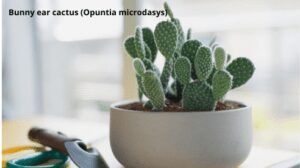
Bunny ear cactus care
This plant is easy to propagate and require lower maintenance
-
Propagation
Bunny ear cactus can propagate simply by taking a pad from the cactus. Take precautions whenever you pick up these plant pads by hand because spines come off with a simple touch.
-
Soil
This plant requires a combination of sand, soil, and peat moss bases for better draining.
-
Water
This plant requires water when the top inch or 2 of soil is dry. Remove excess water because it may cause rotting of roots and stems. During fall and winter, giving water once every three to four weeks is sufficient.
-
Fertilizer
Feed fertilizer mainly low nitrogen to obtain the best growth
-
Light
Full sun, requires bright direct sunlight
-
Repotting
Bunny ears cactus should be repotted every 1 to 2 years. Wait at least a week after repotting to water the plant.
Toxicity to pets
The fruit and flowers are non-toxic to pets, but even the single glochids or spine can irritate the skin.
2. Powder Puff Cactus (Mammillaria bocasana)
Powder puff cactus originated in Northcentral Mexico and may be used as an outdoor plant. This plant is also called “Powder Puff Pincushion”. This cactus rapidly produces many offspring (small, complete daughter plants) which cluster around the parent plant. It has a bluish-green body, compact round shape, and covered with small, silky white, hair-like spines. These hairs coat the reddish-brown spine that also covers the whole cactus. It produces yellow, pink, red, or cream-colored flowers during spring and summer that form a crown on the top. It later emerges as a red fruit that contains reddish-brown seeds.
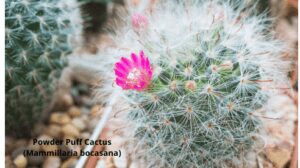
Powder Puff Cactus care
-
Propagation
Powder puff cactus grows from seed like almost any other plant. But it is best to propagate by offsets that are easy to pull away. Use a sharp knife and remove an offset from the main plant and dry it on the paper towel. Before replanting, wait for a few days to allow it to callus formation over the cut surface and then transplanted (3).
-
Light
The plants need to get a lot of sun and warm temperatures. In winter it will become dormant.
-
Water
Add water regularly and thoroughly when the soil becomes nearly dry. Avoid overwatering because it may cause the rotting of roots and stems. Suspend water during the dormant winter period.
-
Repotting
This plant is likely to be a little pot-bound and does not require repotting often. These cacti need repotting every three to five years.
-
Soil
Like all the other succulent types, a porous well-drained soil mixture is essential.
-
Fertilizer
Applying a mild fertilizer solution is helpful for its growth and stops feeding during winter.
Poisonous to pets
This cactus is not generally harmful to pets but take precautions because they are not edible. They may cause stomach upset with possible vomiting when eaten in quantity.
3. Barrel Cactus
Barrel cactus originated in North America and spread up to southern California, southern Arizona. It is also native in Texas and south into Baja, California, and central Mexico. It is a slow-growing plant and can be found on sea bluffs, marine terraces, as well as well-drained inland ridges. The barrel cactus is an outdoor plant that can live to be over 100 years old. This cactus is also known as San Diego Barrel Cactus, mother-in-law cushion, or Compass Barrel. Because they usually lean toward the southwest to prevent surface tissue sunburn. The yellow or orange and purplish-red flowers and yellow fruit always grow at the top of the plant only after many years. The spine color varies from yellow to tan to red, depending on the age of the plant and the species. Some popular varieties of barrel cactus include the golden barrel, California barrel, fishhook cactus, blue barrel, and colviller’s barrel (4).
There are various varieties of Barrel cactus of the two genera Echinocactus and Ferocactus.
- The Ferocactus barrel cactus contains thick barrel cactus (cylindrical shape), prominent ribs, and heavy spines.
- Echinocactus has a hairy crown of fine spines with numerous wavy ribs and elongated fruits. Both of these plants can be grown as a houseplant, let’s look at how to grow barrel cactus with proper care and propagation (5).
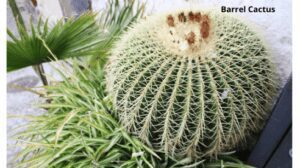
Barrel cactus care
-
Propagation
Barrel cactus can be easily developed from seed by covering it with plastic wrap and keeping it in a warm location.
-
Light
These cacti require plenty of sunlight. If you want to put this cactus indoors keep it near the sunny window.
-
Soil
These cactus need a well-drained mixture of sand, soil, perlite, and compost.
-
Water
This plant requires minimal watering because it is native to arid desert regions and store water in its stem. So add water thoroughly every two to three months and avoid overwatering.
-
Fertilizer
Apply a balanced low nitrogen liquid fertilizer when the plant is in active growth because their nutrient needs are low.
Toxicity to pets
These cacti have spines that may accidentally injure the body so keep them out of reach of pets.
4. Saguaro Cactus (Carnegiea gigantea)
Saguaro cactus is one of the large cactus species, also known as sahuaro. It is native to Mexico and Arizona and California in the United States. This cactus is very slow-growing and can live for 150-200 years thus best to grow indoors. It has a barrel-shaped body, giving it the classic cactus appearance. The Saguaro cactus has smooth, waxy skin and, covered with long spines. Saguaros produce creamy-white flowers in the late spring, and red fruit in summer. It provides nesting for a variety of birds, and the flowers are an important source of nectar for pollinating birds, insects, and bats. It can be used as a food source for humans and wild animals. Freezing temperatures will quickly kill a saguaro, thus take your cactus indoors during the winter season (6).
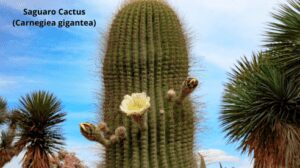
Saguaro cactus care
-
Light
Indoors Saguaro cacti need brightly direct sunlight.
-
Soil
Likewise all other cacti these plants require very well-drained loamy soil.
-
Water
Watering the saguaro cactus in its growing season or soil is completely dry out. Saguaro cactus roots are located near the surface of the soil which soaks up even small amounts of rainfall. This cactus has minimal water needs thus preventing overwatering that may cause rotting of roots.
-
Fertilizer
Fertilize the saguaro cacti with a liquid fertilizer from spring to late summer.
-
Repotting
Saguaro cacti is a very slow-growing cactus and contains a weak root system. So they don’t want to repot frequently. And when repot these cactus roots into the pot, fill the soil until you reach the cactus’ green stem tissue.
Toxic to pets
It is not known to be toxic to pets or humans.
5. Chin Cactus (Gymnocalycium baldianum)
Chin cactus is a perfectly sized cute cactus with a solitary, unbranched, spherical, or flat stem. It has rounded ribs with horizontal separations that create the effect of a row of chin-shaped bumps. This cactus is not spiky and dangerous because its spines are curved toward the stems thus known as “hairless” or “spineless. Chin cactus found throughout the mid to southern regions of South America. It produces funnel-shaped, purple-pink to deep red flowers in early summer (7).
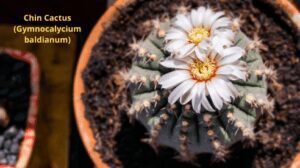
Chin cactus care
-
Fertilizer
Feed the chin cactus with liquid fertilizer monthly when they start growing.
-
Water
These cactus don’t need water every day, allow the soil to dry through watering. Suspend water during winter months when plant growth slows.
-
Light
Chin cactus is a shade-seeking plant, when growing outdoors for the summer, placed in bright, indirect sunlight. To avoid the hot midday sun place this cactus in a south-facing window.
-
Soil
Light, well-drained porous soil is best for growth by combining equal parts of sand and soil.
-
Repotting
This cactus does not need to be repotted very often and can remain in the same pot for 2 to 3 years.
-
Propagation
Chin cactus can be propagated by harvesting its seeds or by the offsets it produces. Baby cacti which grow on the main plant can be cut off and eventually form new plants. This is done by placing the offsets onto a piece of paper towel or in a dry location and allows them to dry out.
Toxic to pets
These cactus contain sharp spines therefore precaution should be needed when handling this plant to prevent injuries.
6. Star Cactus (Astrophytum asterias)
The star cactus is also known as sea urchin cactus or starfish cactus or star peyote or sand dollar cactus. This cactus is usually solitary, small round, dark green to grayish brown, spotted with tiny white dots. The body has eight sections which are decorated with fine white hairs that are spineless. This cactus may grow 2 inches tall to 6 inches wide, making it an ideal house plant. Due to its small size, this cactus is ideal for an indoor succulent garden. This cactus produces yellow or white or red or orange flowers in centers between March and May month. In late spring, these flowers turn into oval woolly berries that can be green, gray, pink, or reddish (8).

Star cactus care
Star cactus needs minimal care like any other cactus.
-
Light
These cactus love to grow in full bright sunlight so place this plant in your home where they got enough direct sunlight
-
Soil
A well-draining porous soil mix is essential for growing a healthy Star Cactus.
-
Fertilizer
Feed the potted plant with a good liquid fertilizer from June until the growing season ends. Suspend feeding during the dormant winter period.
-
Water
The application of water is important for the growth of the plant but also depends on the environmental conditions. Apply water thoroughly when the top of the soil is dry. Forget about watering during winter because the plant may become dormant.
-
Propagation
Star cactus is propagated only by seeds in moist soil which is ideal for germination.
-
Repotting
This cactus doesn’t need repotting very often. Repot the cactus in 2-4 years.
Toxic to pets
star cactus is not toxic if consumed, but its tiny hair may irritate.
7. Fairy Castle Cactus (Acanthocereus tetragonus or Cereus tetragonus)
Fairy castle cactus has many vertical stems that vary in height and appear as tiny towers and turrets. It is native to North, South, and Central America. This slow-growing cactus can reach up to 6 feet in height and rarely produces flowers. When it does, it produces large white or yellow flowers that bloom at night. The green flesh turns woody and brown with age (10 years or more). The clustered growing tips extend and eventually branch out hundreds of green branches. As it grows, the stem has five sides with short white spines growing along the ribs. It grows well indoors and is perfect for beginners.

Fairy Castle Cactus care
-
Light
This plant needs full bright sun but also grows in partial sun to partial shade.
-
Water
Add water thoroughly and then allow the soil to dry out before irrigating. Do not apply overwatering because it may increase the risk of bacterial and fungal infections. In the winter season cut watering by half.
-
Propagation
Propagation by stem cuttings and seeds
-
Soil
This plant requires well-drained soil that makes sure to evaporate excess moisture. You can make good cactus potting soil by mixing one part of potting soil with a part of each of sand and perlite.
-
Fertilizer
In growth season or during spring, feed the plant either mild fertilizer solution through irrigation or apply monthly. Stop feeding in winter.
Toxicity to pets
Generally, it is not toxic to both humans and animals but their sharp spines make them hazardous to pets.
8. Christmas Cactus (Schlumbergera bridgesii)
The Christmas cactus provides a welcome bit of color in autumn and winter sales, native to tropical regions in Brazil. This plant is also known as Epiphytic Cactus (surface growers), those plants which grow on trees and other plants, or on rocks, not in the soil. Christmas cactus has dark-green flattened stems (leaf-like) that are joined by glossy green segments. These leaves have rounded teeth on the margins of the leaves. Flowers emerge at the tips of the stems. The flower blooms around Christmas and is available in red, white, golden yellow, pink, or purple. With proper care, this plant blooms indoor year after year during the holiday season. This cactus is a good option for hanging baskets or to place on top of furniture.

Christmas cactus care
-
Soil
Plant the Christmas cactus in light well-draining soil that is rich in humus and other nutrients.
-
Water
This plant requires moisture for better growth, so keep watering when the top inch or 2 of soil is dry. Remove excess water because it may cause rotting of roots and stems.
-
Light
Christmas cactus needs shady areas or bright indirect light for best growth.
-
Fertilizer
Applying a mild fertilizer solution every 2 weeks helpful for its growth.
-
Repotting
Repotting of Christmas cactus should be done in 1-2 years in spring or early summer and keep up the humidity.
Toxicity to pets
Ingestion of Christmas cactus is toxic for dogs and cats, it may irritate the gastrointestinal tract. After ingestion, it may cause vomiting, diarrhea, depression, and anorexia (eating disorder). Intake of this plant also causes ataxia (brain damage) in cats. However, these signs are mild and stay until they digest but it is dangerous from aged animals.
9. Moon Cactus (Gymnocalycium mihanovichii or Hibotan cactus)
Moon cactus is known as ruby red cactus, moon cactus, ruby ball cactus, red top, and red cap cactus. This type of cactus is native to South America and has a short life even with good care. This plant is slow growing but easy to grow even if you have a small garden or a balcony without too much trouble. Moon cactus has no chlorophyll content for photosynthesis. Therefore, it relies on the other cactus as a food source by grafting in which it sustains itself for several years. Grafted moon cactus plants stay small, under 6 inches tall. This plant is available in different colors such as hot pink, brilliant orange, and neon yellow. Many people mistake the colored ball on top of a flower when it is the plant itself.

Moon cactus care
-
Water
This plant doesn’t need too much water, keep the gap between watering. Suspend watering in the winter months because the plant may become dormant.
-
Fertilizer
Feed the cactus during the growing season (April to September) for the colorful healthy cactus. Suspend feeding during the dormant winter period.
-
Light
These cacti require bright indirect sunlight or partial sun or shadow.
-
Soil
Well-drained soil is ideal for good plant growth.
-
Propagation
The moon cactus is generally sold after grafting thus they are not suitable for propagation. However, the life of this cactus can be extended by re-grafting it onto a fresh cactus.
Toxicity to pets
No known source says that this is a poisonous plant.
10. Queen of the night cactus(Epiphyllum oxypetalum)
This cactus is also known as Dutchman’s pipe cactus, princess of the night, orchid cactus, and night-blooming cereus. These perennial cacti are native to the dry regions of Mexico and South America. This plant produces large, fragrant white flowers that open only at night in spring or early summer. Providing proper care can encourage more flowers.
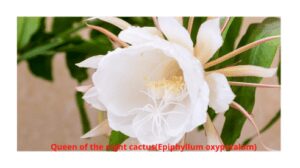
Queen of the night cactus care
-
Light
Queen of the night cactus needs bright indirect light or partial shade.
-
Water
Apply water thoroughly and regularly but remove the excess water does not allow the soil’s surface to feel dry out completely.
-
Fertilizer
Feed the plant with low-nitrogen liquid during the growth season (spring and summer) is ideal for the best growth.
-
Repotting
After bloom faded, this plant can repot in a large container.
-
Propagation
This cactus is easily propagated by cutting from the long flat arching stems.
Toxicity to pets
Generally not known to be toxic to animals or humans.

[…] cactus (Cereus hildmannianus; Family Cactaceae) is a slow-growing, evergreen, tree-like cactus. This cactus is generally found in sandy and rocky soils. It is famous by the name “Queen of […]